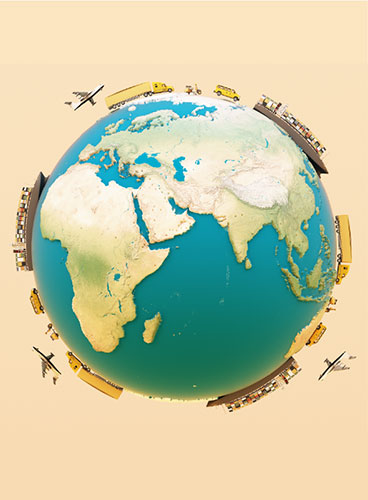AuroraTec goes international
Building the start-ups within the start-up
When we talk about international business, we often think about global supply chains and logistics, the use of foreign workers, and the importing and exporting of goods and services across various national, regional and continental borders. While these are all indeed aspects of how many large international businesses operate, others centre on an international presence of a different sort. In particular, managerial decisions about where to sell a good or service are an important part of many growth strategies. Since the move towards a more globalized world in the mid to late twentieth century, many more companies look to sell their goods or services internationally, even when they are relatively small.
Within this episode, we see that dot-com technology companies, which were famously located in California, were heavily invested in expanding into multiple international markets.
About globalization
Globalization represents the shift in economic activities towards a more integrated and interdependent form of business. There are main types of globalization that have impacted businesses and societies in very different ways. First, the globalization of markets relates to the fact that previously separate geographical markets have merged into one global market. On the other hand, globalization of production is the use of goods and services from international locations that take advantage of differences in cost or quality compared to domestic alternatives.
Hill, Charles (2014), International Business: Competing in the Global Marketplace, McGraw-Hill Education.
Photo credit: istockphoto.

In the market for a new European partner
In the spring of 2000, having successfully secured funding for the US-based activities, AuroraTec (a pseudonym) began to pursue expansion into multiple new international markets. The product offered by AuroraTec was fundamentally connected to the Internet, translating websites designed for desktops into mobile readable versions. Like the Internet, the potential markets were not physically limited by distance or borders. Websites were all over the world, so they could be too. Thus, as they started to look overseas, first to Europe, where their plan was to acquire a company that would provide a ready-made presence.
From: Jennifer Corby
Sent: Thursday, May 25, 2000 4:38 PM
To: Doug Roberts
Cc: Luke Golden
Subject: Info promised
Stateside firm that assists companies in expanding into Europe. Have no idea whether they are any good or not. Met through a trade show.
The company in Europe that Blue Octopus says is so hot is CUBE - www.cube.com - they don't yet have a presence in the US - and are very consumer focused. Could be a could m&a candidate - gets us European presence, gets them US presence/distribution. Just a thought.
Let us know if there is any help you need from marketing.
jc
Jennifer Corby
Chief Marketing Officer
AuroraTec, Inc.
From: Luke Golden
Sent: Thursday, May 25, 2000 9:26 PM
To: Jennifer Corby; Doug Roberts
Subject: RE: Info promised
Doug,
What exactly are you looking for? I've still got quite a few
contacts in the VC and Tech world in London.
Also, I saw Cube while I was still workign there and they were just starting out. Xwave actually hosts them. I'm not too impressed. If we're looking for Euro partners, I'd suggest 3: Red.com, Doctor, and Web Village. The latter two are strong Pan-Euro Internet/WAP development shops (started in Germany). ALso two big SIs: Puzzle and Sigma.
Luke
Enabling Infrastructure for Post-PC Era
************************************
Luke Golden Director of Strategic Marketing AuroraTec, Inc.
From: Jennifer Corby Sent: Friday, May 26, 2000 7:36 PM To: Luke Golden; Doug Roberts Subject: RE: Info promised
I think what we are looking for is a strong European player that does not yet have a US presence. The goal would be to find someone to acquire in an all stock transaction. This would build our valuation in a demonstrable way which a JV would not. However, the BOD directed us to look at doing a joint venture. I want to make sure that we are looking at all of our options to build our capabilities for Europe.
From: Doug Roberts To: Jennifer Corby, Luke Golden Subject: Europe Date: 29 May 2000 16:17:18 UTC
I second Jennifer's thoughts on approaches to Europe. An acquisition could be a solid approach. For the JV approach, we are looking for financial players as well as key partners that could help us launch the company in Europe (admininstrative, marketing, sales and technical).
Any suggestions regarding acquisition candidates, partners or funding sources appreciated.
Doug Roberts Vice President Global Telecom Business Unit
M&A or JV?
Find out more
Seeking visibility in new markets
Additionally, while the firm’s initial entry strategy was still just forming, the Chief Marketing Officer, Jennifer, was already trying to keep a handle of an already growing campaign, much of which was focused on building the profile for the business in Europe and courting particularly large and important leads. However, with so many different trade events and conferences, and with such a fledgling international presence, there was a question about whether resources should be directed towards developing business leads so soon, though some within the firm were clearly keen.
From: Jennifer Corby
Sent: Thursday, June 01, 2000 2:53 PM
To: Sebastian Dobson; Luke Golden
Cc: Doug Roberts; Rick O’Connor
Subject: Go/no go decision on Wireless World
How much will it cost to participate in Wireless World Europe - incremental to what we've already invested?
Should we be planning on participating? Or - is it too early to be generating demand for Europe. If we are planning on participating, should we invite 5 very very high level contacts to participate, learn about Europe and how they are implementing mobile?
What's the last day we need to make this decision? I'm conscious of the fact that it is now June 1, which puts us 6 weeks out from the event which is July 10th.
I'm ok in NOT PARTICIPATING if we do not feel it will be worthwhile in terms of leads etc. What I'm not OK with is NOT MAKING A DECISION. Remember no decision is a decision.
Jc
Jennifer Corby
Chief Marketing Officer
AuroraTec, Inc.
From: Luke Golden
Sent: Thursday, June 01, 2000 3:27 PM
To: Jennifer Corby; Sebastian Dobson
Cc: Doug Roberts; Rick O’Connor
Subject: RE: Go/no go decision on Wireless World
Incremental costs will include flights and hotel for AuroraTec personnel, flights to Europe for any invitees and the time that could be dedicated to other projects/initiatives. It will give us visibility in Europe, its probably a nice boondoogle for prospective customers. We need to discuss how it fits with the European strategy and how much Sales and Bus Dev thinks it adds to their chance to close deals - ASAP
Enabling Infrastructure for Post-PC Era
************************************
[Reply message]
From: Rick O’Connor
Sent: Thursday, June 01, 2000 6:27 PM
To: Luke Golden
Cc: Jennifer Corby
Subject: RE: Go/no go decision on Wireless World
Think "Big Time"
Costfinder
Priority Investments
River
PT Frances
Andrews
Park
Lots of 'Big Time"
Let me know if we are serious and I will start calling, but I'm
going as well.
Rick
[Reply message]
From: Luke Golden
Sent: Thursday, June 01, 2000 7:25 PM
To: Rick O’Connor
Cc: Jennifer Corby; Sebastian Dobson
Subject: RE: Go/no go decision on Wireless World
I think we must do it.
Enabling Infrastructure for Post-PC Era
************************************
Luke Golden
Director of Strategic Marketing
AuroraTec, Inc.
From: Luke Golden
To: Jennifer Corby
Subject: RE: Go/no go decision on Wireless World
Date: 01 Jun 2000 22:28:12 UTC
BTW, where are we with Andrew. I believe he would be very unhappy if we pulled out - since it would show less support for him. A refund is of course out of the question, given that we're not doing Wireless World US either.
Luke
Enabling Infrastructure for Post-PC Era
************************************
Luke Golden
Director of Strategic Marketing
AuroraTec, Inc.
From: Sebastian Dobson
Sent: Friday, June 02, 2000 6:20 AM
To: Luke Golden; Rick O’Connor
Cc: Jennifer Corby
Subject: RE: Go/no go decision on Wireless World
Agree. I will meet with Rick and Doug to finalize attendees. The show prep is already underway.
From: Luke Golden
To: Sebastian Dobson, Rick O’Connor
Cc: Jennifer Corby
Subject: RE: Go/no go decision on Wireless World
Date: 02 Jun 2000 20:08:45 UTC
You da MAN
Enabling Infrastructure for Post-PC Era
************************************
Luke Golden
Director of Strategic Marketing
AuroraTec, Inc.
Conflicting priorities
However, not only were there questions over the costs, but the Vice President in charge of AuroraTec’s global business, Doug Roberts, and its European Managing Director, Michel Dupont, were not even aware it was in the calendar. Moreover, Michel questioned the sense in attending, highlighting that it was ‘just another’ event and that AuroraTec was not ready to capitalize on such profile-building opportunities.
From: Doug Roberts
Sent: Friday, June 02, 2000 7:51 AM
To: Jennifer Corby; Sebastian Dobson; Luke Golden
Cc: Rick O’Connor
Subject: RE: Go/no go decision on Wireless World
Importance: High
What is Wireless World? Is this in Europe?
Doug Roberts
Vice President
Global Telecom Business Unit
From: Luke Golden
To: Doug Roberts, Jennifer Corby, Sebastian Dobson
Cc: Rick O’Connor
Subject: RE: Go/no go decision on Wireless World
Date: 02 Jun 2000 15:53:58 UTC
Wireless World Europe is a conferenece in Barcelona this July that we are sponsoring. I believe Sebastian is in contact with you about it. More details can be found at http://www.wirelessworld.com/. Key from our standpoint is who we want to invite as complimentary attendees (we can nominate 5-10 senior level IT folk - preferably from top prospects)
Enabling Infrastructure for Post-PC Era
************************************
Luke Golden
Director of Strategic Marketing
AuroraTec, Inc.
From: FW: Doug Roberts
Sent: Freitag, 2. Juni 2000 10:26
To: Michel Dupont; Kovin Pathirana
Cc: Jennifer Corby; Sebastian Dobson; Ravi Chowdury
Subject: FW: Go/no go decision on Wireless World
Michel -
Ravi and Jennifer plan on attending this event in Barcelona, which I believe is scheduled for July 10. I was not aware of this event until I received the attached. Apparently it is a 3 day event, to which we can invite up to 10 clients/potential clients. Airfare and conference fees will be paid for the clients. Please let me know who would like to invite and Sebastian will handle the invitations from here.
Jennifer, Sebastian - please let me know our conference schedule for the rest of the year.
Doug Roberts
Vice President
Global Telecom Business Unit
From: Michel Dupont
To: Doug Roberts, Kovin Pathirana
Cc: Jennifer Corby, Sebastian Dobson, Ravi Chowdury
Subject: RE: Go/no go decision on Wireless World
Date: 02 Jun 2000 21:31:24 UTC
To all,
I am somewhat surprised that this event is back on the table. During my last visit in Santa Clara it was on the table but then cancelled. May I offer the following thoughts to the event:
1. Wireless World is - put simply - another event. Over the last two days alone, AuroraTec Europe was invited to sponsor and lead several major conferences organized by IAC , CMI or similar outfits. Every week in Europe there is some GALA event that any wireless player cannot afford to miss and has the unique opportunity to sponsor, lead keynote speeches, have priveleged cocktail receptions and leaflet handouts on delegate seats, ...etc. Without any bias, therefore, let me state that there are many such events around the topic wireless internet. Just today AT has been invited to take a lead role at the next GSM World Forum and the WAP Platform in Sevilla.
2. I would like to support Jennifer`s suggestion that it is premature to schedule such an event with invitees by beginning July. Kovin and I are in the process of building a strong lead list and new leads are not necessary at this point. The objective we have is to CLOSE first deals asap and then build on the momentum from that. The value added to make a grand appearence at this or any other event in this short timeframe will make no difference on the deal closure potential in Europe. In short, we do not need leads but require the first 1-2 closures that we can follow through on and deliver professionally.
3. If there exists a concern on my part, then it is more about execution then lead generation. AuroraTec in europe is a start-up within a start-up. We may have excellent contacts, but in order to deliver professionally the market will expect responsiveness, local presence, and to a degree resource size (unless we license and train large partners). My suggestion would be to use the resource and finance available of this event to help close the first 1-3 bluechip carrier or enterprise deals and to deliver on these.
4. To achieve maximum marketing impact, I would suggest that we take a lead role in such an event following a european kick-off meeting riding on the basis of 2-3 closed bluechip contracts (similar to the US launch). While we should annouce in a separate press release the opening of our european operations, the appropriateness of a type european launch is called for following first successes. I realize that this was not the intention of AT at Wireless World but this point can be seen as related.
Please understand these thoughts not as a unwillingness to support the planned event. We are not aware of the priveleges or benefits that may have been negotiated for AT around this event and perhaps they are unique and should be considered. Please advise on above thoughts.
Michel
From: Michel Dupont
To: Jennifer Corby, Sebastian Dobson
Cc: Doug Roberts, Kovin Pathirana
Subject: FW: Go/no go decision on Wireless World
Date: 06 Jun 2000 03:56:09 UTC
Jennifer/Sebastian,
Have not heard a response and am wondering whether this mail was lost in the system crash ....
Best, Michel
From: Sebastian Dobson
To: Michel Dupont, Jennifer Corby
Cc: Doug Roberts, Kovin Pathirana
Subject: RE: Go/no go decision on Wireless World
Date: 06 Jun 2000 13:32:52 UTC
There are two separate discussions here. The first is Wireless World Europe and the second is a European launch.
Let's take them separately.
Wireless World Europe is an event that we are committed to attend. We will bring over 5 U.S. customers and want 5 European high-level customers invited. This is an all expenses paid event.
The European Launch is also something that we should discuss, but I am not sure E-mail is the best medium. You have some great suggestions, but we are missing a couple of pieces: colocation and language support. This needs to be a separate discussion that you should drive.
Back to Wireless World Europe. Are there five potential customers that you would like to invite?
Sebastian
Shifting to a joint venture approach
As the person responsible for the firm’s market entry strategy, Doug spent much of the summer trying to find other companies to take a share in the new venture. Rather than the acquisition they had been looking to initially make in Europe, the firm’s strategy had moved towards a joint venture instead. The potential JV partners Doug was seeking would provide much of the necessary capital needed to fund AuroraTec’s international expansion after the recent crash and had local knowledge of their particular market that the firm could exploit.



